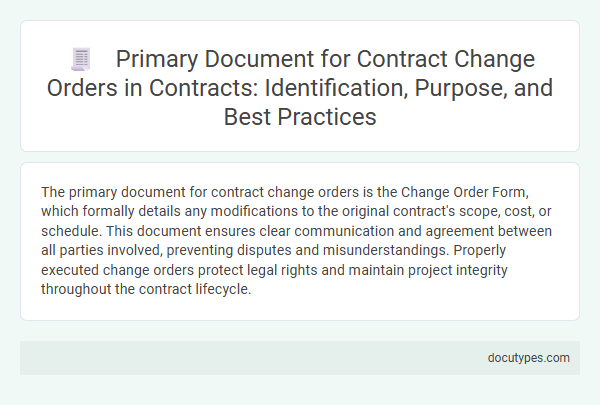The primary document for contract change orders is the Change Order Form, which formally details any modifications to the original contract's scope, cost, or schedule. This document ensures clear communication and agreement between all parties involved, preventing disputes and misunderstandings. Properly executed change orders protect legal rights and maintain project integrity throughout the contract lifecycle.
Understanding Contract Change Orders: Definition and Importance
Contract change orders are formal documents that authorize modifications to the original terms of a contract. They are essential for managing changes in scope, cost, or schedule during a project.
The primary document for contract change orders is the Change Order Form, which clearly details the agreed-upon adjustments between parties. This form records changes such as additional work, revised deadlines, or altered payment terms, ensuring legal and financial clarity. Understanding contract change orders helps prevent disputes by maintaining transparent communication throughout the project lifecycle.
Primary Documents in Contract Change Management
| Topic | Details |
|---|---|
| Primary Document for Contract Change Orders | The primary document used in contract change management is the Change Order Form. This form acts as the official record for modifications in scope, schedule, or cost agreed upon by all contracting parties. It ensures clarity, accountability, and legal enforceability of contract alterations. |
| Role of Primary Documents | Primary documents serve as authoritative references that track all contractual adjustments. They enable project managers and stakeholders to validate changes, prevent disputes, and maintain compliance with contract terms. |
| Key Elements of Change Order Forms | These documents typically include change description, reason for change, impact on cost and timeline, approvals from authorized personnel, and signatures. Proper documentation supports effective contract change management and protects your interests. |
| Importance in Contract Change Management | Using primary documents like change orders secures transparency and facilitates communication among parties. They help mitigate risks associated with unapproved changes and provide a clear audit trail during contract execution. |
Identification of Key Change Order Documents
The primary document for contract change orders is the Change Order Request form, which officially outlines proposed modifications. This document serves as the formal basis for reviewing, approving, and implementing contract changes.
- Change Order Request Form - Details the scope, cost, and schedule adjustments requested for contract modifications.
- Approved Change Order - The signed document that authorizes alterations after review and agreement by all parties.
- Supporting Documentation - Includes technical specifications, cost breakdowns, and impact analyses that justify the change order request.
Essential Components of Change Order Forms
What is the primary document for contract change orders? The primary document for contract change orders is the Change Order Form. This form specifies the adjustments to the original contract terms, including scope, cost, and schedule changes.
What are the essential components of change order forms? Essential components include a clear description of the change, the reason for the change, cost implications, revised timelines, and approvals from authorized parties. These elements ensure proper documentation and agreement on modifications affecting the contract.
How does the change order form protect your interests in a contract? A well-drafted change order form provides a written record of agreed modifications, preventing disputes and ensuring transparency. You maintain control over the project's scope, budget, and schedule by having documented consent from all involved parties.
Roles and Responsibilities in Change Order Documentation
The primary document for contract change orders is the Change Order Form, which formalizes modifications to the original contract. This document ensures all parties acknowledge and approve the agreed-upon changes before implementation.
- Owner's Role - The owner reviews and authorizes change order requests to ensure modifications align with project goals and budget constraints.
- Contractor's Responsibility - The contractor submits detailed change order proposals outlining scope, cost, and schedule impacts for owner approval.
- Project Manager's Task - The project manager coordinates communication and documentation, verifying that all changes are accurately recorded and approved.
Tracking and Recording Contract Modifications
The primary document for contract change orders is the Change Order Form. This form is essential for accurately tracking and recording any modifications to the original contract terms.
Change Order Forms detail the scope, cost, and schedule adjustments agreed upon by all parties. Proper documentation ensures transparency and helps prevent disputes during project execution.
Legal Requirements for Change Order Documentation
The primary document for contract change orders is the Change Order Form or Change Order Agreement. This form legally records any modifications to the original contract scope, cost, or timeline.
Legal requirements for change order documentation demand clear descriptions of changes, approval signatures, and adherence to contract terms. Your compliance with these requirements ensures enforceability and prevents disputes.
Best Practices for Drafting Change Order Documents
The primary document for contract change orders is the Change Order Form, which serves as the official record of modifications to the original contract terms. Clear and detailed drafting of this document ensures all parties agree on the scope, cost, and timeline adjustments.
- Clarity and Precision - Use explicit language to define the scope and impact of the changes to avoid misunderstandings.
- Inclusion of Essential Details - Include specific information such as cost adjustments, schedule changes, and signatures from authorized personnel.
- Consistency with Original Contract - Align the change order document with the original contract terms and legal requirements to maintain enforceability.
Your careful attention to these best practices enhances transparency and reduces disputes during contract modifications.
Common Pitfalls in Change Order Documentation
The primary document for contract change orders is the Change Order Form, which officially records modifications to the original contract scope, cost, or schedule. Common pitfalls in change order documentation include unclear descriptions, lack of proper authorization, and incomplete cost or time impact analysis. These issues often lead to disputes, delays, and budget overruns, emphasizing the need for precise and thorough documentation.
What Is the Primary Document for Contract Change Orders? Infographic

